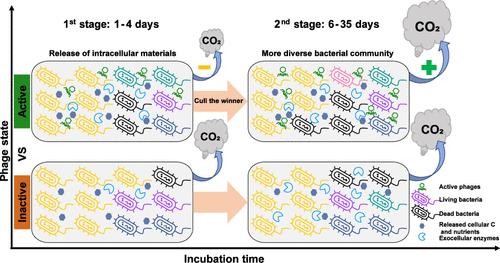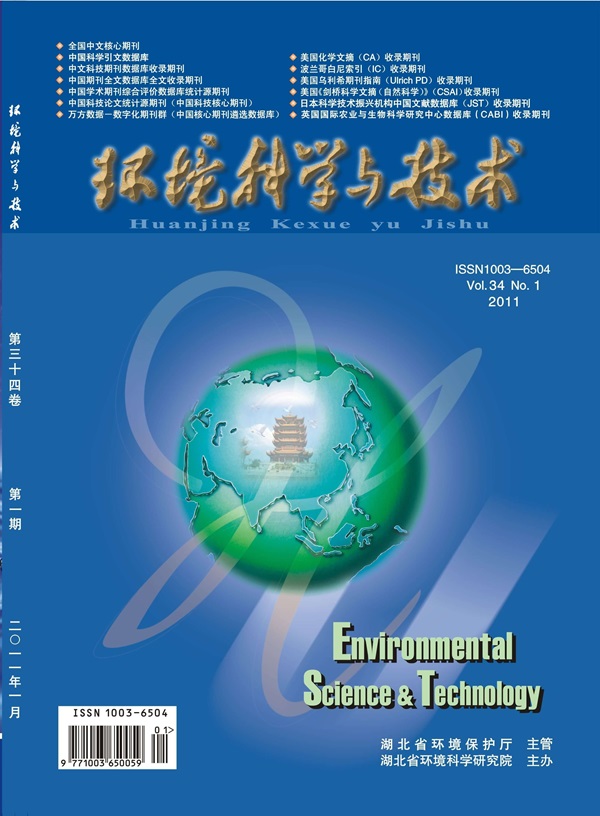噬菌体通过塑造细菌群落影响土壤溶解有机质矿化
IF 10.8
1区 环境科学与生态学
Q1 ENGINEERING, ENVIRONMENTAL
引用次数: 0
摘要
病毒被认为可以调节细菌群落和陆地养分循环,但它们对细菌代谢的影响以及溶解有机物(DOM)矿化过程中碳(C)动力学的机制尚不清楚。在这里,我们将活性和非活性噬菌体(噬菌体)添加到具有原始细菌群落的土壤DOM中,并在18°C或23°C下孵育35天。噬菌体最初(1-4天)在18°C时降低了13-21%的二氧化碳排出率,在23°C时降低了3-30%,但显著(p <;0.05), 6天后在18°C和23°C下分别增加了4-29%和9-41%,累计二氧化碳排放量在18°C和23°C下分别增加了14%和21%。噬菌体减少了优势细菌分类群,增加了细菌群落多样性(与“淘汰赢家”动态一致),从而改变了预测的微生物组功能。具体来说,噬菌体丰富了一些参与降解复杂化合物的分类群(如假单胞菌、厌氧柱菌和Caulobacter),从而促进了与C循环相关的功能。较高的温度促进了噬菌体与细菌的相互作用,增加了细菌多样性和酶活性,使DOM矿化率提高了16%。总的来说,噬菌体通过改变微生物群落和功能来影响土壤DOM的矿化,适度的温度变化调节了这些过程的大小,但没有从质量上改变它们的行为。本文章由计算机程序翻译,如有差异,请以英文原文为准。

Phages Affect Soil Dissolved Organic Matter Mineralization by Shaping Bacterial Communities
Viruses are considered to regulate bacterial communities and terrestrial nutrient cycling, yet their effects on bacterial metabolism and the mechanisms of carbon (C) dynamics during dissolved organic matter (DOM) mineralization remain unknown. Here, we added active and inactive bacteriophages (phages) to soil DOM with original bacterial communities and incubated them at 18 or 23 °C for 35 days. Phages initially (1–4 days) reduced CO2 efflux rate by 13-21% at 18 °C and 3–30% at 23 °C but significantly (p < 0.05) increased by 4–29% at 18 °C and 9–41% at 23 °C after 6 days, raising cumulative CO2 emissions by 14% at 18 °C and 21% at 23 °C. Phages decreased dominant bacterial taxa and increased bacterial community diversity (consistent with a “cull-the-winner” dynamic), thus altering the predicted microbiome functions. Specifically, phages enriched some taxa (such as Pseudomonas, Anaerocolumna, and Caulobacter) involved in degrading complex compounds and consequently promoted functions related to C cycling. Higher temperature facilitated phage-bacteria interactions, increased bacterial diversity, and enzyme activities, boosting DOM mineralization by 16%. Collectively, phages impact soil DOM mineralization by shifting microbial communities and functions, with moderate temperature changes modulating the magnitude of these processes but not qualitatively altering their behavior.
求助全文
通过发布文献求助,成功后即可免费获取论文全文。
去求助
来源期刊

环境科学与技术
环境科学-工程:环境
CiteScore
17.50
自引率
9.60%
发文量
12359
审稿时长
2.8 months
期刊介绍:
Environmental Science & Technology (ES&T) is a co-sponsored academic and technical magazine by the Hubei Provincial Environmental Protection Bureau and the Hubei Provincial Academy of Environmental Sciences.
Environmental Science & Technology (ES&T) holds the status of Chinese core journals, scientific papers source journals of China, Chinese Science Citation Database source journals, and Chinese Academic Journal Comprehensive Evaluation Database source journals. This publication focuses on the academic field of environmental protection, featuring articles related to environmental protection and technical advancements.
 求助内容:
求助内容: 应助结果提醒方式:
应助结果提醒方式:


